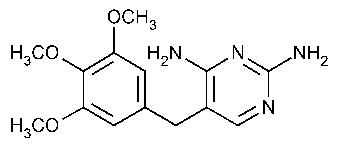Trimethoprim
»Trimethoprim contains not less than 98.5percent and not more than 101.0percent of C14H18N4O3,calculated on the dried basis.
Packaging and storage—
Preserve in tight,light-resistant containers.Store at 25 ,excursions permitted between 15
,excursions permitted between 15 and 30
and 30 .
.
Identification—
A:Infrared Absorption á197Sñ—
Solution:
1in 100.
Medium:
chloroform.
B:
Transfer about 100mg of it,accurately weighed,to a 100-mLvolumetric flask,and dissolve in 25mLof alcohol.Dilute quantitatively and stepwise with sodium hydroxide solution (1in 250)to obtain a 1in 50,000solution:the UVabsorption spectrum of this solution exhibits maxima and minima only at the same wavelengths as that of a similar solution of USP Trimethoprim RS,concomitantly measured;and the respective absorptivities,calculated on the dried basis for the test sample only,at the wavelength of maximum absorbance at about 287nm do not differ by more than 3.0%.
Loss on drying á731ñ—
Dry it in vacuum at 105 for 4hours:it loses not more than 0.5%of its weight.
for 4hours:it loses not more than 0.5%of its weight.
Residue on ignition á281ñ:
not more than 0.1%.
Chromatographic purity—
Buffer solution—
Prepare a 10mMsodium perchlorate solution in water,adjust with phosphoric acid to a pHof 3.6,and mix.
Mobile phase—
Prepare a filtered and degassed mixture ofBuffer solution and methanol (7:3).Make adjustments if necessary (seeSystem SuitabilityunderChromatography á621ñ).
Resolution solution—
Dissolve accurately weighed quantities of USP Trimethoprim RSand diaveridine;and dilute quantitatively,and stepwise if necessary,withMobile phase to obtain a solution having known concentrations of about 10µg per mLand 5µg per mL,respectively.
Test solution—
Transfer about 25.0mg of Trimethoprim,accurately weighed,to a 25-mLvolumetric flask,dissolve in and dilute withMobile phase to volume,and mix.
Chromatographic system(see Chromatography á621ñ)—
The liquid chromatograph is equipped with a 280-nm detector and a 4.6-mm ×25-cm column that contains base-deactivated packing L1.The flow rate is 1.3mLper minute.Chromatograph the Resolution solution,and record the peak responses as directed forProcedure:the resolution,R,between the peaks for trimethoprim and diaveridine is not less than 2.5;and the relative standard deviation for replicate injections is not more than 2.0%.
Procedure—
Inject a volume (about 20µL)of theTest solution into the chromatograph,record the chromatogram for not less than 11times the retention time of the trimethoprim peak,and measure all of the peak responses.Calculate the percentage of each impurity in the portion of Trimethoprim taken by the formula:
100{Fri/[S(Fri)+FrT]},
in whichFis a relative response factor,and is equal to 0.5for any peak having a relative retention time of 0.9,2.3,2.7,or 10.3,and is equal to 1.0for all other peaks;riis the peak response for each impurity;andrTis the peak response for trimethoprim obtained from theTest solution:not more than 0.1%of any individual impurity is found;and not more than 0.2%of total impurities is found.
Assay—
Transfer about 300mg of Trimethoprim,accurately weighed,to a conical flask,add 60mLof glacial acetic acid,and titrate with 0.1Nperchloric acid VS,determining the endpoint potentiometrically.Perform a blank determination,and make any necessary correction.Each mLof 0.1Nperchloric acid is equivalent to 29.03mg of C14H18N4O3.
Auxiliary Information—
Staff Liaison:Behnam Davani,Ph.D.,MBA,Senior Scientist
Expert Committee:(PA7)Pharmaceutical Analysis 7
USP28–NF23Page 1987
Pharmacopeial Forum:Volume No.29(6)Page 1995
Phone Number:1-301-816-8394
